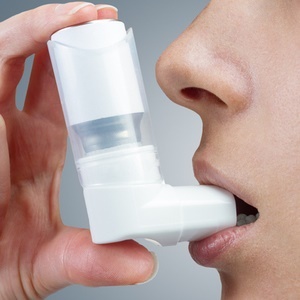
In this article, we take a closer look at the peak expiratory flow rate (PEFR) – the maximum flow rate generated during a forceful exhalation.
What is a peak-flow meter?
A peak-flow meter helps you to assess your response to treatment, evaluate triggers that worsen your asthma symptoms, and establish a baseline against which you can measure your asthma control, and whether it’s becoming better or worse.
A peak-flow meter is a small, hand-held device that measures your ability to force air out of your lungs. The maximum speed of breathing air out of your lungs is called your peak flow, and is measured as litres of air/minute. The measure of your peak flow is a measure of your lungs’ capacity.
Your peak-flow reading will help you to determine whether you’re losing asthma control. It’s a sensitive measure that allows you to respond quickly to flare-ups before they become acute attacks that may land you in hospital.
Every asthmatic should have a peak-flow meter. It’s simply not enough to work entirely on how you’re feeling without knowing your peak-flow reading. You can start to lose control of your asthma before noticing any changes in your breathing or exercise capacity.
If your asthma is well controlled and you have no inflammation or narrowing of the airways, you can force a lot of air out of your lungs that will give you a higher reading on the peak-flow meter. As you develop inflammation in your lungs, you won’t be able to force as much air out of your lungs and your peak-flow reading will be lower.
Peak-flow meters are small enough to carry around with you and they’re easy to use: place your lips around the mouthpiece and blow out as hard as you can. Your peak flow number is measured on the side of the instrument.
Your doctor will advise you on which model to buy and exactly how to use it. It you don’t have a peak-flow meter, contact your medical scheme about obtaining one.
What do the peak-flow readings mean?
When you first use a peak-flow meter, you can determine your ‘personal best’ score at a time when the asthma is controlled. There are also charts to show what your score should be according to your height and age.
Remember that peak flow can vary from day to day, as well as with the time of the day – even if your asthma is well controlled. It’s a good idea to always measure at the same time of day for consistency.
Interpreting the numbers is simple. Think of your peak flow as falling into three colour zones:
- The Green Zone: This is when your peak flow is between 80% and 100% of your personal best. Your aim is to stay in this zone because this is where you know that your asthma is well-controlled. You can lead a normal life and your medication is working.
- The Yellow Zone: This is when your peak flow is 60 to 80% of your personal best. This means ‘caution’. You’re not as well controlled as you could be and your asthma is getting worse. You need to review your medication, reduce your exposure to triggers and contact your doctor to discuss a plan of action.
- The Red Zone: This equals DANGER! Your peak flow is less than 60% of your personal best.
If your asthma is so bad that you can barely record a peak flow, you must seek medical help immediately.
Reviewed by independent healthcare consultant Prof Praneet Valodia and pulmonologist Prof Elvis Irusen, Head of the Division of Pulmonology at the Faculty of Medicine and Health Sciences, Stellenbosch University. October 2018.




 Publications
Publications
 Partners
Partners











